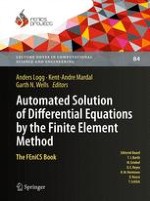This book is a tutorial written by researchers and developers behind the FEniCS Project and explores an advanced, expressive approach to the development of mathematical software. The presentation spans mathematical background, software design and the use of FEniCS in applications. Theoretical aspects are complemented with computer code which is available as free/open source software. The book begins with a special introductory tutorial for beginners. Following are chapters in Part I addressing fundamental aspects of the approach to automating the creation of finite element solvers. Chapters in Part II address the design and implementation of the FEnicS software. Chapters in Part III present the application of FEniCS to a wide range of applications, including fluid flow, solid mechanics, electromagnetics and geophysics.
